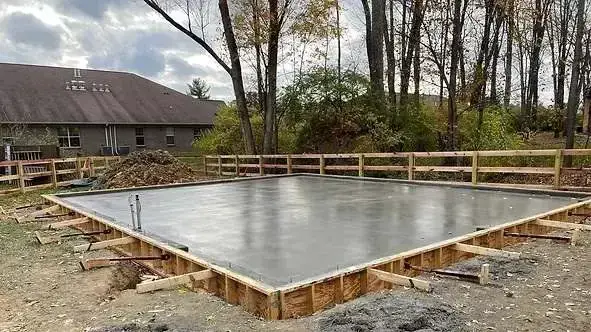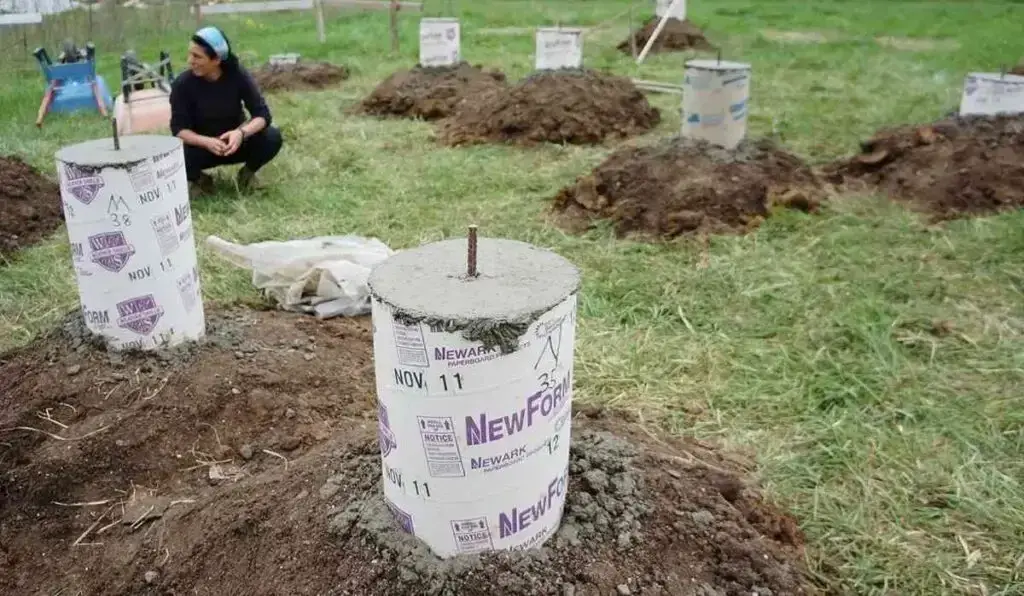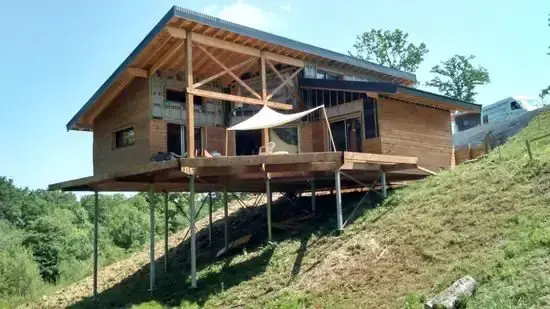Unveil the mystery! Curious about shipping container foundation requirements? Let’s decode the essentials for a rock-solid start to your container home journey.
When it comes to shipping container structures, a solid foundation is absolutely crucial. Not only does it provide stability and structural integrity, but it also ensures the long-term durability and safety of your container-based project.
In this comprehensive guide, we will walk you through the key topics and considerations when it comes to shipping container foundation requirements, enabling you to make informed decisions and lay the groundwork for a successful and secure structure.
Table of Contents
Ground Conditions and Soil Testing
The Significance of Soil Conditions for Foundation Requirements
When it comes to shipping container foundation requirements, one crucial aspect that cannot be overlooked is the ground conditions and soil composition.
The type and characteristics of the soil on which your shipping container will be placed have a direct impact on the stability and durability of the foundation. Understanding the significance of soil conditions is essential to ensure a strong and secure foundation.
Soil Testing: Determining Foundation Specifications
Soil testing plays a vital role in determining the specifications of your shipping container foundation. It involves evaluating various factors such as compaction, drainage, and load-bearing capacity of the soil.
All in all, by conducting thorough soil testing, you can accurately determine the appropriate foundation design and construction techniques needed to safely support your shipping container structure.
Factors Affecting Foundation Requirements
Several factors need to be considered when assessing foundation requirements based on ground conditions and soil testing results:
- Compaction: Soil compaction refers to the degree to which the soil particles have been compressed. Adequate compaction is crucial to prevent settlement and ensure structural stability.
- Drainage: Good drainage is essential to prevent water accumulation around the foundation. Poor drainage can lead to soil erosion and foundation failure.
- Load-Bearing Capacity: Basically, the load-bearing capacity of the soil determines its ability to support the weight of the shipping container and any additional loads imposed on it. It is important to ensure that the soil can adequately bear the intended loads.
Read More on Do Shipping Container Homes Need a Foundation?
Footing and Pad Construction

Without a doubt, proper footing and pad construction is crucial for ensuring the stability and longevity of shipping container foundations. Here, we will provide an overview of the construction process and the selection of suitable materials for stability and weight distribution.
Overview of the Construction Process
The construction process for footings and pads involves several key steps to ensure a strong foundation for your shipping container. These steps include:
- Excavation of the area where the footings and pads will be placed
- Compacting the soil to provide a stable base
- Adding a layer of gravel or crushed stone for drainage and further stability
- Installing formwork to define the shape and size of the footings and pads
- Pouring the concrete or placing the gravel within the formwork
- Smoothing the surface and curing the concrete to achieve maximum strength
Selection of Suitable Materials
The choice of materials for footings and pads depends on various factors such as the soil conditions, expected loads, and local building codes. Concrete and gravel are the two commonly used materials, each offering unique advantages.
Concrete certainly provides exceptional strength and durability, making it an excellent choice for heavy-duty applications. It is resistant to weathering and can distribute the weight of the shipping container evenly across the foundation.
Gravel is a cost-effective alternative that provides good drainage and stability. It is particularly suitable for areas with poor soil conditions or where weight distribution is not a concern.
Steps to Ensure Proper Footing and Pad Construction
To ensure the proper construction of footings and pads, follow these essential steps:
- Work with a qualified engineer or contractor to determine the appropriate size and depth of the footings and pads based on the expected loads and soil conditions
- Ensure proper compaction of the soil to provide a stable base for the foundation
- Add a layer of gravel or crushed stone for improved drainage and stability
- Use formwork to shape and contain the concrete or gravel during installation
- Follow recommended curing times for concrete to achieve optimal strength
- Regularly inspect the footings and pads for any signs of damage or deterioration
By following these steps and using the suitable materials, you can ensure a solid and reliable foundation for your shipping container structure.
Read More on An Excellent Guide for Shipping Container Home Foundation
Anchoring and Tie-Downs
The Importance of Securely Anchoring Shipping Containers to Foundations
The anchoring of shipping containers is a crucial aspect of their foundation requirements. Securely anchoring containers to foundations ensures stability and prevents movement, especially in areas prone to high winds, earthquakes, or other environmental factors.
Evidently, without proper anchoring, containers can shift, tilt, or even topple over, posing potential safety risks and damaging the structure itself.
Various Anchoring Methods
There are several methods available for anchoring shipping containers to foundations:
- Twist Locks: Twist locks are commonly used in container shipping to connect containers together. They can also be utilized to anchor containers to foundations, providing a reliable and easily adjustable anchoring solution.
- Ground Anchor Systems: Ground anchor systems involve using anchors, cables, and braces to secure containers to the ground. These systems offer excellent stability and are particularly effective in areas with unstable soil or high wind conditions.
- Concrete Castings: Concrete castings involve embedding anchor points or loops into the concrete foundation during the construction process. This method provides a solid and durable anchoring solution.
Specific Anchoring Techniques Based on Foundation Requirements
The specific anchoring techniques to be used depend on the foundation requirements of the shipping container structure.
Factors such as soil conditions, local building codes, and environmental conditions must be considered when determining the appropriate anchoring method.
Consulting with a structural engineer or a professional familiar with shipping container foundations can help determine the most suitable anchoring techniques for a specific project.
- Comprehensive guide to helical piles.
- Co-authored by industry-leading experts, with contribution from landmark projects.
- Detailed assessments of site conditions, load types, pile materials, and testing parameters.
- Insightful case studies for real-world applications of how helical piles worked in different projects.
- Maximum capacity estimates, correlative to both graphical and established models.
- Step-by-step directions for the implementation of helical piles.
- Explanations of failure modes, selection of remedial methods, and advice on efficient installation techniques.
Read More on Shipping Container Home Foundation Ideas: Ultimate Guide
Building Codes and Regulations
First thing to remember, understanding local building codes and regulations relevant to shipping container foundations is crucial to ensure the safety and legality of your structure.
These codes and regulations vary depending on your location, so it’s important to research and adhere to the specific requirements set by your local authorities.
Compliance with codes, permits, and additional requirements specified by local authorities is essential. These regulations are put in place to maintain the structural integrity of buildings and protect occupants from potential hazards.
Adhering to regulations not only ensures your shipping container foundation meets safety standards, but also helps you avoid potential legal issues in the future. In addition, non-compliance with building codes can result in fines, penalties, or even the demolition of your structure.
Before starting your project, make sure to consult with local authorities and obtain the necessary permits. This could include permits for construction, zoning, and inspections. By following the proper procedures, you can minimize potential delays and ensure that your shipping container foundation meets all necessary requirements.
Read More on Building A Container Home in Florida – How To Build One
Environmental Considerations
When designing a foundation for shipping containers, it is crucial to take into account the various environmental factors that can impact the stability and durability of the structure. Addressing these considerations will ensure a safe and long-lasting foundation.
Frost Lines
One important environmental factor to consider is the frost line. Frost lines indicate the depth at which the ground freezes during the coldest winter months.
And so it is crucial to design the foundation below the frost line to prevent any movement or shifting caused by freezing and thawing of the soil. Consult local building codes or geotechnical reports to determine the frost line in your specific area.
Seismic Activity
Important to realize that in regions prone to seismic activity, it is essential to design the foundation to withstand ground shaking and potential lateral forces.
The foundation should be reinforced and securely anchored to resist movement during an earthquake. Consult with a structural engineer to determine the appropriate design considerations for your location’s seismic activity level.
Wind Loads
Considering wind loads is crucial, especially in areas prone to hurricanes, strong winds, or gusts. The foundation should be designed to resist the lateral forces exerted by high winds.
This can be achieved through appropriate anchoring and bracing techniques. Consult local building codes or a structural engineer to determine the necessary wind load requirements for your location.
Read More on How To Get Permits For Container Homes In Florida
Determining the Appropriate Foundation Design
Each location comes with unique environmental requirements, necessitating a tailored foundation design. In a word, it is important to assess the specific soil conditions, frost lines, seismic activity, and wind loads in your area.
By considering these factors, you can determine the most appropriate foundation design that will ensure the stability and longevity of your shipping container structure.
Read More on The Best Container Home Builders in Central Florida
Leveling and Grading
Achieving a level foundation surface and proper grading for container stability is crucial to ensure the structural integrity and longevity of your shipping container structure.
Without proper leveling and grading, your container may experience structural issues, such as uneven weight distribution and potential shifting.
Techniques for Leveling and Grading the Foundation Site
There are several techniques you can employ to level and grade the foundation site for your shipping container:
- Laser Leveling: Using a laser leveling tool, you can accurately measure and adjust the site’s elevation to ensure a level surface. This technique ensures precision and eliminates human error in the leveling process.
- Manual Grading: If you’re working on a smaller scale project, manual grading can be a cost-effective option. It involves using hand tools such as shovels, rakes, and tampers to remove or add soil where needed, creating a level surface.
- Heavy Equipment: For larger projects, heavy equipment such as bulldozers and graders can be used to remove excess soil, fill in low areas, and level the site efficiently. This method is faster but may require skilled operators.
- Retaining Walls: In some cases, retaining walls may be needed to achieve the desired level and prevent erosion. These walls hold back soil and create a flat surface for your container foundation.
Read More on How Much Is A Container Home in Florida? Your Ultimate Guide
Necessary Excavations and Considerations for Leveling the Area
Before beginning the leveling process, it’s essential to conduct proper excavations and consider certain factors:
- Clear the Site: Remove any vegetation, rocks, or debris that may interfere with the leveling process.
- Assess Drainage: Ensure proper drainage on the site by determining the natural flow of water and incorporating appropriate measures like sloping or installing drainage systems.
- Soil Testing: Conduct soil testing to determine the stability and load-bearing capacity of the soil. This will help you understand whether additional preparation, such as compacting or adding fill, is necessary.
- Mark the Boundaries: Clearly mark the boundaries of the foundation area to guide the leveling and grading process accurately.
By following these techniques and considerations, you can create a level foundation surface and proper grading, providing a stable base for your shipping container structure.
Read More on The Container Store Raleigh, North Carolina: Home Organization
Cost and Time Considerations
When it comes to shipping container foundation construction, there are important factors to consider, both in terms of cost and time. Let’s explore the key considerations:
Exploring the Cost Implications
Building a foundation for a shipping container involves certain expenses that need to be taken into account. These costs generally include the materials, labor, and equipment required for construction.
- Materials: The type and quality of materials used can significantly impact the overall cost of the foundation. Common materials for foundation construction include concrete, rebar, gravel, and forms.
- Labor: The cost of labor depends on factors such as the complexity of the foundation design, the number of workers required, and the prevailing labor rates in the area.
- Equipment: Specialized equipment may be needed to excavate the site, level the ground, and pour the foundation. The cost of renting or buying such equipment should be considered.
Read More on Container Home Builders Maryland – Innovative Skills
Estimating the Overall Timeline
The timeline for completing a shipping container foundation can vary depending on various factors:
- Size and complexity: Larger foundations or those with more intricate designs may require more time for construction.
- Weather conditions: Inclement weather can cause delays, especially during excavation and pouring of the foundation.
- Availability of resources: Adequate availability of labor, equipment, and materials can impact the overall timeline.
When planning your shipping container project, it’s essential to factor in these cost and time considerations to ensure a well-managed and efficient foundation construction process.
Read More on Are Container Homes Legal in Maryland? Professional Review
Foundation Alternatives
When it comes to shipping container foundations, there are alternative options to consider. In summary, these alternatives provide flexibility in terms of installation, suitability for different ground conditions, and cost. Here, we will discuss a few popular alternatives for shipping container foundations:
1. Helical Pier Systems

Helical pier systems involve the use of screw-like anchors that are drilled deep into the ground. Unquestionably, these anchors provide excellent stability and support for shipping container structures.
They can be easily installed without the need for extensive excavation or concrete work. Helical pier systems are especially suitable for areas with unstable soil conditions.
Read More on Shipping Container Anchors: 10 Of The Best Anchors!
2. Precast Concrete Blocks

Must be remembered that the precast concrete blocks are a simple and cost-effective foundation alternative for shipping containers. These blocks can be easily arranged in the desired configuration to form a stable foundation.
They can be particularly useful for sites where leveling and grading are challenging. Precast concrete blocks are durable and resistant to environmental conditions.
3. Pile Foundations

Pile foundations involve the use of deep vertical columns or piles that are driven into the ground. These piles provide a strong and stable base for shipping container structures.
Pile foundations are commonly used in areas with soft or sandy soil, as they help distribute the weight of the structure over a larger area. They require professional installation and may be more expensive in comparison to other alternatives.
The suitability of these alternative foundations depends on various factors, including ground conditions, load requirements, local building codes, and budget constraints.
Consulting with a structural engineer or foundation specialist is crucial to determine the most appropriate foundation option for your specific scenario.
Read More on How To Build A Container Home Step-by-Step For Beginners And Starters
Maintenance and Inspections
Regular maintenance and inspections are crucial for the long-term success of your shipping container foundation. These activities help ensure the foundation’s durability and the safety of your storage containers.
Importance of Ongoing Foundation Maintenance and Inspections
By conducting regular maintenance and inspections, you can identify and address any potential issues before they escalate into costly problems.
Ongoing inspections allow you to assess the overall condition of both the container and the foundation, ensuring they remain in optimal working condition.
Periodic Checks, Repairs, and Potential Modifications Based on Container and Foundation Condition
Regular checks help you identify any structural damage or wear and tear that may impact the foundation’s integrity. This includes inspecting the container for rust, corrosion, or evidence of pests that can compromise the foundation’s strength.
Additionally, monitoring the foundation for settling, cracks, or shifts is important to address any potential stability issues.
Repairs and modifications should be performed promptly to maintain the foundation’s safety and functionality. This may involve reinforcing weak areas, repairing damaged sections, or adjusting the tie-downs and anchoring systems as needed.
Read More on Can You Put a Basement Under a Shipping Container Home?
Ensuring the Longevity and Durability of the Foundation and the Storage Containers
Through regular maintenance and inspections, you can extend the lifespan of both the foundation and the storage containers. Timely repairs and modifications help prevent further damage, ensuring their long-term durability.
By taking these proactive steps, you can minimize the risk of structural failures or safety hazards associated with an unsound foundation.
Read More on Container Vegetable Gardening In Central Florida – Latest Ideas
Key Considerations for Shipping Container Foundation Location
Choosing the right location for your shipping container foundation is crucial to ensure the stability and longevity of your structure.
Evaluating the Ground Suitability for Foundation Construction
Before selecting a location, it is essential to evaluate the ground conditions to determine its suitability for foundation construction.
Conducting soil testing is a critical step in this process, as it helps identify any potential issues that may affect the stability of the foundation.
Factors such as soil type, bearing capacity, moisture content, and drainage should be considered to ensure a solid foundation.
Factors Impacting the Choice of Foundation Location
Several factors can impact the choice of foundation location for shipping container structures. The proximity to utilities such as water, electricity, and sewage systems is one important factor to consider.
Accessibility for transportation and loading/unloading operations should also be taken into account. Additionally, the surrounding landscape, including trees, sloping terrain, and nearby structures, can influence the decision on the foundation location.
Ensuring the Structural Integrity of the Shipping Container Foundation
To ensure the structural integrity of the shipping container foundation, it is important to comply with building codes and regulations specific to your area.
Adhering to these guidelines will help ensure that the foundation meets the necessary safety standards. Additionally, proper anchoring and tie-down techniques should be employed to secure the shipping container and prevent any movement or shifting that could compromise the foundation’s stability.
Read More on Best 15 Home Energy Efficiency Improvements: 2023
Solid Concrete Foundations for Shipping Container Structures
The use of solid concrete foundations for shipping container structures offers various benefits and is highly suitable for ensuring stability and longevity.
Benefits and Suitability
- Durability: Solid concrete foundations provide a strong and long-lasting base for shipping container structures. They can withstand heavy loads and adverse weather conditions, ensuring the overall stability of the structure.
- Structural Integrity: Concrete foundations offer excellent support and prevent shifting or settling of the containers. This is particularly important for multi-story container buildings or structures located in high wind or seismic zones.
- Fire Resistance: Concrete is a non-combustible material, making it ideal for foundations of shipping container structures. It minimizes the risk of fire damage and enhances the safety of the occupants.
- Ease of Construction: Constructing a solid concrete foundation can be relatively simple and straightforward, especially with experienced contractors. It involves pouring concrete into footings or piers and allowing it to cure for optimal strength.
Construction Process and Considerations
To ensure the successful construction of a solid concrete foundation for shipping container structures, the following considerations should be taken into account:
- Site Preparation: The construction site needs to be excavated and leveled to provide a stable platform for the foundation.
- Formwork: Formwork is essential to contain the poured concrete and shape it into the desired foundation structure. It should be well-designed to prevent leaks and ensure accurate dimensions.
- Reinforcement: Steel reinforcement, such as rebar, should be incorporated to enhance the strength and structural integrity of the foundation.
- Pouring and Curing: The concrete mixture needs to be poured evenly and allowed to cure properly for optimum strength and durability. Curing time may vary depending on environmental conditions.
Ensuring Stability and Longevity through Solid Concrete Foundation Design
Proper design and engineering of the solid concrete foundation are crucial for the stability and longevity of shipping container structures.
- Load Bearing Capacity: The foundation design should consider the anticipated loads and forces exerted on the structure, ensuring the foundation can adequately support them.
- Drainage: Adequate drainage measures should be incorporated into the foundation design to prevent water accumulation and potential damage to the containers.
- Slope and Elevation: The foundation should be designed to ensure proper slope and elevation, allowing for effective water runoff and preventing moisture-related issues.
- Insulation and Vapor Barrier: If necessary, insulation and vapor barrier materials can be incorporated in the foundation design to enhance energy efficiency and moisture control.
Read More on How To Optimize Your Tesla Powerwall During A Power Outage


